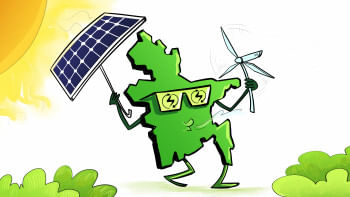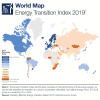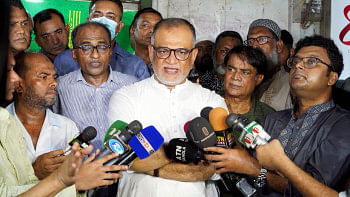Bangladesh’s energy transition journey so far

Worldwide, there is increasing focus on the energy transition, which entails achieving complete decarbonisation of the global energy system by 2050. Situated in the Global South, Bangladesh encounters substantial challenges as it grapples with the consequences of climate change. Despite contributing significantly less to carbon emissions than developed nations, the country remains highly vulnerable to the adverse effects of climate change. Bangladesh's trajectory towards energy transition has been challenging but also provides valuable opportunities for other countries to learn from it.
Even though Bangladesh contributes only 0.56 percent to global greenhouse gas emissions, it ranks as the seventh most vulnerable nation to the impacts of climate change. According to the Climate Risk Index 2021, Bangladesh experienced the loss of 11,450 lives and incurred economic losses amounting to $3.72 billion. It witnessed 185 extreme weather events between 2000-19, all attributed to the effects of climate change. Looking ahead to 2050, the country faces the alarming prospect of losing one-third of its agricultural GDP due to climate variability and extreme events. This is particularly concerning given that the agriculture sector constitutes roughly half of the country's employment.
The World Bank reports that Bangladesh has invested approximately $10 billion in climate-resilient infrastructure since 1972. This investment has proven effective, leading to a reduction of annual economic losses from natural disasters by around one percent of the GDP. Notably, the country boasts over 14,000 cyclone shelters with a combined capacity to accommodate 2.4 million people. Over the past 25 years, this infrastructure has contributed to a 75 percent reduction in fatalities during cyclones. To further address climate-related risks, Bangladesh allocates a substantial budget of about $3 billion annually for adaptation and disaster management, further demonstrating its commitment to resilience. Despite these efforts, approximately two percent of the GDP is consistently lost due to the impact of natural calamities and environmental degradation.
Bangladesh has set ambitious goals to reduce carbon emissions by 21.8 percent by 2030, focusing on increased use of renewable energy and energy efficiency, as outlined in its 2021 nationally determined contributions (NDCs). As a Climate and Clean Air Coalition partner, Bangladesh is committed to substantial reductions, aiming to decrease black carbon emissions by 72 percent and methane by 37 percent by 2040. Approximately six to seven percent of the annual budget is allocated to enhance climate resilience through adaptation initiatives, with 75 percent of funding sourced domestically. The Bangladesh Climate Change Trust Fund (BCCTF) finances over 800 projects dedicated to effective climate adaptation and mitigation.
Bangladesh currently incorporates 2.93 percent of renewable energy, amounting to 650.14 MW, within its overall energy mix, while the total installed power capacity stands at 22,215 MW. A substantial portion (48 percent or 10,678 MW) of the total power generation relies on natural gas. The primary renewable resources in Bangladesh, including solar, wind, hydro, and biomass, are determined based on the country's geographical location. As of June 2023, these resources collectively hold an installed capacity of 1,183 MW, constituting 4.5 percent of the total installed capacity. Here, solar power takes the lead, contributing approximately 80 percent, including off-grid and on-grid systems.
Despite the intentions outlined in Bangladesh's 2008 renewable energy policy, which aimed for 10 percent of electricity to be sourced from renewables, the country has achieved a modest three percent from renewable sources. Despite initial targets of generating five percent of its electricity from renewables by 2015 and 10 percent by 2020, as of June 2023, Bangladesh has fallen well short of these goals. The government has now established new objectives, aiming to achieve 15 percent of electricity from renewables by 2030, 40 percent by 2041, and 100 percent by 2050.
In alignment with its commitment to a low-carbon development path, Bangladesh is increasingly focusing on renewable energy and energy efficiency. The country has installed 541.7 MW capacity solar power plants, with an additional 911.8 MW in progress, alongside a 149 MW wind power plant. Moreover, over 6 million solar home systems have been installed in off-grid areas, and 4.5 million improved cook stoves have been distributed in rural regions across the country.
Bangladesh has emerged as a trailblazer in adopting nature-based solutions (NbS) to supplement the impact of energy transition and address the challenges of climate change, exemplified by initiatives like mangrove restoration, floating agriculture, and community-based forest management. By incorporating NbS into energy transition strategies, there is an opportunity to create a more holistic and sustainable approach that considers both environmental conservation and the shift toward cleaner energy sources. The country's innovative approach serves as a model, offering valuable lessons for neighbouring South Asian nations on integrating climate resilience into national development programmes and establishing a sophisticated financial framework. Development partners can draw insights from Bangladesh's experience and replicate successful strategies in other countries.
Setting a precedent, Bangladesh was the first developing country to formulate a coordinated action plan in 2009 known as the Climate Change Strategy and Action Plan. Additionally, it established a Climate Change Trust Fund with an allocation of $300 million from domestic resources spanning 2009 to 2012. Bangladesh's proactive and comprehensive approach to tackling climate change and advancing sustainable development offers a compelling blueprint for other nations, especially those encountering similar issues in the Global South. Despite contributing minimally to global greenhouse gas emissions, Bangladesh has displayed a pronounced vulnerability to the impacts of climate change, underscoring the pressing need for adaptive measures.
The nation's investments in climate-resilient infrastructure, nature-based solutions, and renewable energy reflect a holistic commitment to mitigating environmental risks and promoting sustainable practices. In order to address the financing gap to implement this holistic approach, Bangladesh uses innovative financial mechanisms, such as the Bangladesh Climate Change Trust Fund and the allocation of a substantial portion of the annual budget to climate-related endeavours. The BCCTF can be made more sustainable if each development project contributes to it through an eco-compensation cess, thus reducing the dependence of the fund on budgetary support. The experiences of Bangladesh can serve as a valuable repository of insights for other countries on the crucial integration of climate resilience into national development plans and the effective utilisation of domestic resources for impactful climate initiatives. Bangladesh's journey towards energy transition is likely to remain challenging, but there is light at the end of the tunnel.
Sudhir Muralidharan is country manager of the United Nations Office for Project Services (UNOPS), Bangladesh.
Prof Syed Munir Khasru is chairman of international think-tank The Institute for Policy, Advocacy, and Governance.
Views expressed in this article are the author's own.
Follow The Daily Star Opinion on Facebook for the latest opinions, commentaries and analyses by experts and professionals. To contribute your article or letter to The Daily Star Opinion, see our guidelines for submission.

 For all latest news, follow The Daily Star's Google News channel.
For all latest news, follow The Daily Star's Google News channel. 











Comments